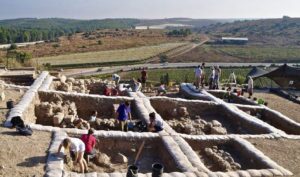
It was a desperate time. Knowing that the massive army of Babylonia’s King Nebuchadnezzar was decisively making its way through the countryside, he could see that, one by one, the defensive strongholds of the Kingdom of Judah were falling.
“Let my lord know that we are watching over the beacon of Lachish, according to the signals which my lord gave, for Azekah is not seen,” wrote officer Hoshaiah to Yaush.
Yaush was the commanding officer of Lachish. At the time Hoshaiah was writing, Lachish was a major city within the Kingdom of Judah. Azekah, the other town mentioned by Hoshaiah, was another fortified settlement in the region. The statement was written about 2600 years ago with carbon ink in ancient Hebrew upon a clay fragment of pottery. This artifact is among those that testify to the days just before the fall of the ancient Kingdom of Judah to Nebuchadnezzar’s fateful military campaign. Like other ancient sites in what is today modern Israel, the ancient city paints for us through its archaeological remains a compelling and tumultuous historical narrative.
Located near the present-day Israeli city of Kiryat Gat, it is arguably one of the most famous sites in the ancient Near East. Not only has it been referenced in the Bible, but in the Amarna tablets and other Egyptian and Assyrian sources, as well. “We have the iconography, and the Biblical text, and of course the site describes itself as we excavate it,” says Professor Yosef Garfinkel of Hebrew University of Jerusalem’s Institute of Archaeology. Garfinkel has been leading an excavation project at Tel Lachish (the tel or mound that contains its ancient remains), along with Professor Michael Hasel at Southern Adventist University and a team of archaeologists, for five years. “It’s a meeting point between everything: history, iconography, and archaeology.”
Off and on for well over 80 years, since the first expedition under James Leslie Starkey in the 1930’s, Tel Lachish has yielded hundreds of thousands of artifacts, including structural features such as massive fortification walls, ramparts, palaces and temples — and Garfinkel’s recent expedition has uncovered some remarkable new findings, particularly as they relate to the ancient Canaanite occupation of the site.
_________________________
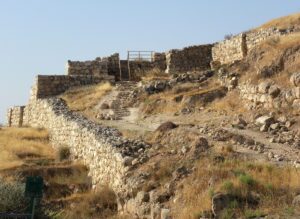
Main gate at the Lachish archaeological site. Wilson44691. Creative Commons Attribution-Share Alike 3.0 Unported license. Wikimedia Commons
_________________________
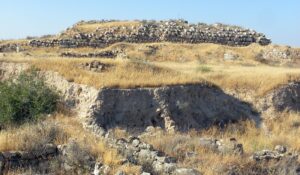
Remains of the commanding officer’s house or palace at Lachish. Wilson44691. Creative Commons Attribution-Share Alike 3.0 Unported License. Wikimedia Commons
_________________________
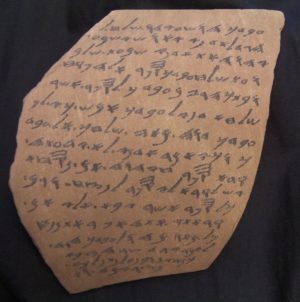
Lachish Letter III, one of the Lachish letters written on a potsherd (ostrocon) discovered at Tel Lachish during earlier excavations. Public Domain, Wikimedia Commons
_________________________
The Canaanite Temple
According to the Biblical tradition, Joshua conquered and destroyed the Canaanite city of Lachish. Subsequently, the ancient Israelites rebuilt and transformed the ancient city into a major stronghold of their own.
“We know that Lachish was the second most important city in the kingdom of Judah,” Garfinkel explains. “Today you have Jerusalem and Tel Aviv. In ancient times you had Jerusalem and Lachish. One of the interests we have in the Canaanite culture is that the Biblical text is against the Canaanite cult. When the people of Israel come, they destroy the Canaanite high places, they break the standing stones, they break and destroy the altars, and the rest. We see that the [writers of] the Bible really hate this Canaanite religion because it was more pagan, and the Biblical text—the theology at least—is [documenting the creation of] a new religion: monotheism. They [the Canaanites] created an iconic kind of religion, so they [the ancient Israelites] were against the pictures and statues of the Canaanites, and everything the Canaanites did was forbidden.”
Garfinkel and his team hope to shed additional light on this ancient culture. During excavations beginning in 2013, Garfinkel and colleagues began to uncover the remains of what they identified as a Canaanite temple rich in artifacts, a relatively rare find in the archaeology of the Levant. Lachish was a city that was built, destroyed, and rebuilt several times in its history under varying occupations. Garfinkel explains: “The Canaanite temple [we uncovered] is from the last Canaanite city occupation. This city was destroyed first around 1200 BCE; this is Level 7. Then the local Canaanites rebuilt it again; this is Level 6. Our temple is from Level 6 and was destroyed about 50 years later at around 1150 BCE. After the destruction of Level 6, the whole area was deserted for about 200 years before being rebuilt again. A Canaanite temple in Nablus was excavated in the beginning of the 20th century, and then a second in a different location was excavated by the Oriental Institute in the 1920s and 1930s. Both temples were found empty, with almost no meaningful objects found within. In the 1950s, another type of Canaanite temple was discovered, but again yielded very little helpful information. Since then, we haven’t really had much information.”
Until Garfinkel’s recent excavation.
“The Canaanite city was destroyed, and the temple was completely destroyed, but it’s amazing because it was not heavily looted,” he explains. “We found gold artifacts, silver artifacts, bronze artifacts, pottery and stone vessels… We have a lot of wonderful discoveries. This temple was loaded with objects—cultic objects and other kinds of objects—so not only is the architecture important here, but what we find inside as well.”
Garfinkel explains that he and his team came to Lachish to investigate Level 5 (a later time period) and found a new city wall in their excavations. “We used carbon dating that placed it at the end of the 10th century BCE,” he goes on. “This fits very nicely with the Biblical tradition. Now, I’m not a religious person. For me, the Bible is not a holy script; I’m not trying to prove it. We have the historical tradition, though, and we need to see if the archaeology can support it or not. Sometimes it does, and sometimes it doesn’t. In this case, we know that Level 5 was fortified at the same time described in the Biblical text.”
“Excavating the Canaanite temple has nothing to do with the Biblical tradition in this case, but it is a very important discovery to understand the Canaanite culture,” continues Garfinkel. “Every culture is important. This is part of the big puzzle of understanding the human past. And this is what I’m trying to do.”
The overall design of this temple compares similarly to other Canaanite temples in northern Israel, such as Nablus, Megiddo and Hazor. The structural layout consists of two columns and two towers in front, leading into a large hall. The inner space featured four columns and several “standing stones” interpreted to be possible representations of gods. Its shape and side room features resemble the typical design of later temples, such as Solomon’s Temple.
__________________________
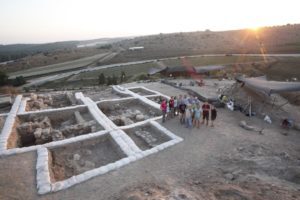
Above and below: Canaanite Temple at Tel Lachish. Archaeologists work to excavate the Biblical city of Lachish. (Yosef Garfinkel) Courtesy of the Fourth Expedition to Lachish
__________________________
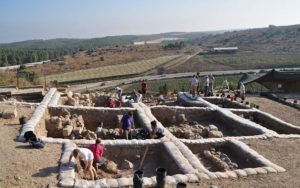
__________________________
The Finds Within
Among the artifacts uncovered during excavations were two fully intact cauldrons made of bronze. This was a rare occurrence, making them the first complete cauldrons to be found in the region. Prior to this discovery, Garfinkel explains that it is common to find small fragments or the handles of cauldrons, but never a complete piece. In addition to the two cauldrons, a silver pendant with an Egyptian-style naked goddess holding flowers, Egyptian scarabs, and silver earrings were uncovered, as well as a small, boat-like object made from bronze and covered in gold with an inscription of Ramses II. Two bronze figurines depicting smiting gods were also found in the temple’s ‘Hall of Holies’, holding a mace in their hands in a fighting stance. “We’ve also discovered gold,” Garfinkel says. “Gold earrings, gold sheets, gold beads… I’ve never found so much gold in my life!”
Perhaps the most interesting discovery, however, was a pottery sherd, or ostracon, engraved with ancient Canaanite script. It includes the letter “samekh”, which is characterized by a vertical line crossed by three perpendicular shorter lines. As such, it is the oldest known example of this letter and important to research on ancient alphabets.
“What do we know about the alphabet, really?” asks Garfinkel. “It was invented by the Canaanites under Egyptian influence at around 1800 BCE. The number of Canaanite inscriptions is very small. In all these years [since we’ve been excavating Canaanite sites] there’s less than twenty inscriptions. Most of them are very short, with only a few words. Over the years, we’ve found most of the letters, like L, F, A, B, C, D, F, and so on, but one letter was never found until now.” Samekh is not found in the English language, but it is a major letter in Semitic script.
In early civilizations like Mesopotamia and Egypt, difficult systems of writing were developed, like cuneiform and hieroglyphics. These were complicated systems, inaccessible and requiring special training to understand. Typically, only scribes could read and write in these societies. The Canaanite alphabet, on the other hand, started at 32 letters but was eventually reduced to 22 letters in total. This writing system was much more accessible, and soon anyone could learn how to read and write, much like today. “This is the most important contribution of the Canaanites to world culture,” Garfinkel says.
__________________________
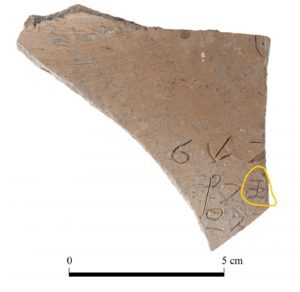
A Canaanite storage jar sherd with an inscription bearing the letter “samekh.” T. Rogovski
__________________________
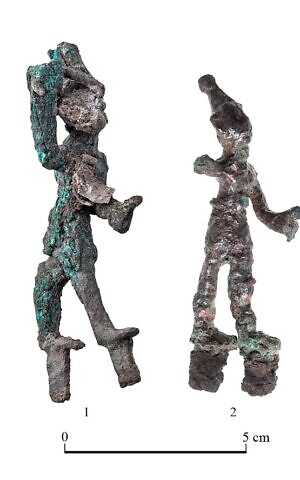
Two smiting gods uncovered at the Canaanite temple at Lachish. T. Rogovski
__________________________
Going Forward
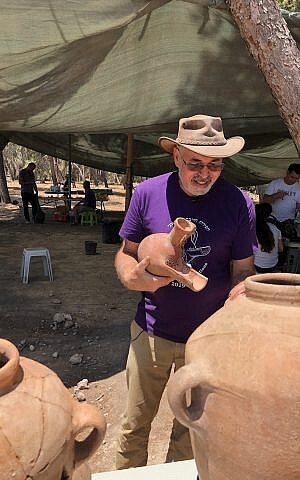
Prof. Yosef Garfinkel, head of the Institute of Archaeology at the Hebrew University in Jerusalem, at the Khirbet a-Ra‘i excavation, on July 8, 2019. Times of Israel
Next year, Garfinkel and his team will not be returning to Lachish. “We are moving to another important Canaanite site, Tel Hazor,” he explains. “Hazor was the largest Canaanite city in the region. Just to give an example, Lachish is 7.5 hectares. Hazor is 80 hectares. It is more than ten times bigger than Lachish; it was like New York, or Tokyo. It was the largest city in the Near East [for its time]—not just there, but in the Southern Levant, in this region of Israel, Lebanon, Syria, and so on.” Hazor was a major cultural center, and Garfinkel and his team hope this new expedition will shed more light on the Canaanite culture.
Professor Garfinkel invites anyone who might be interested to join him in helping to excavate the past: “Every summer, there are twenty to thirty excavations [in Israel], and volunteers can join and work for anywhere from two to six weeks.”




